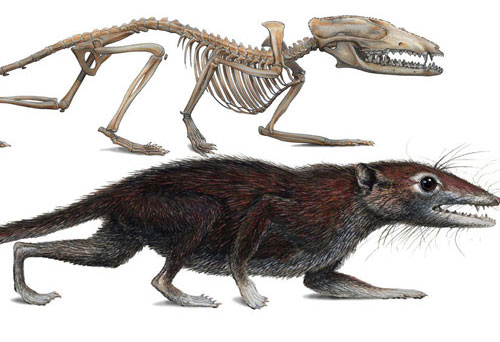Found 'Jurassic mother'
The oldest fossils of most mammals today, including humans, have been discovered.
Called Juramaia ( Jurassic mother ) sinensis, small shrew-shaped animals often climb trees to find worms and also to avoid being eaten by meat or crushed dinosaurs. " Since this animal lived 160 million years ago, and no one signed a birth certificate for its descendant, Juramaia sinensis could be our distant great-grandmother. You don't need to be a dinosaur. In the end, the little animal prevailed, and without Juramaia sinensis, you and I weren't here to chat, ' said paleontologist Zhe Xi Luo. Natural History Museum of Pittsburgh, Pennsylvania (USA) and the leader of the research team, said.

Species Juramaia sinensis - (Photo: Discovery)
According to Nature science jury, Luo and Chong Xi Yuan, Qing Jin Meng and Qiang Ji collaborators analyzed the remains of the animal, found in Liaoning province, northeastern China and saved. Hold at Beijing Natural History Museum. The fossils include a missing skull, traces of soft tissue, complete teeth and front leg bones. Based on these characteristics, experts concluded that Juramia sinensis is closer to placental animals on the mammal genealogy tree than marsupials like kangaroo.
Prior to the discovery, scientists had DNA evidence showing the common ancestor of mammal mammals and mammals that lived 160 million years ago, but the oldest animals were found. See that Eomaia lived 125 million years ago. The discovery of Juramaia sinensis filled the remaining 35 million years.
The forelegs of Juramaia sinensis adapted to clinging to the branches and running fast, the abilities that are useful in the context of many larger animals, including dinosaurs, travel below to find prey. Juramaia sinensis weighs less than half a kilogram, its teeth are sharp and can chew on insects. Associate Professor Gregory Wilson, of the University of Washington's Department of Biology, said the findings help reinforce the understanding of the evolutionary landscape of mammals.
- Jurassic fossils discovered Jurassic sea 10m long
- Found 3,000 species of bacteria from the Jurassic period in Mexico
- Long-necked sea monsters dominate the Jurassic ocean
- Going for a walk, 5-year-old baby found what the scientific world desires
- Learn the history and meaning of Mother's Day
- Every woman who is old is like her mother
- The real 'Jurassic Park' is about to appear
- More than 100 mother octopus hatched eggs in the deep sea
- Jurassic monster revealed
- Monkey got a teddy bear as a mother
- How was the Jurassic World movie created?
- Jurassic Park on a plate
 Discovered an ancient centipede fossil 99 million years old
Discovered an ancient centipede fossil 99 million years old Discovered bat-like dinosaurs in China
Discovered bat-like dinosaurs in China Discovered a 200-year-old bronze cannon of the coast
Discovered a 200-year-old bronze cannon of the coast Discover 305 million-year-old spider fossils
Discover 305 million-year-old spider fossils